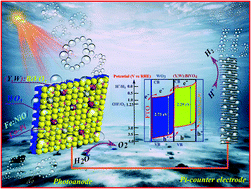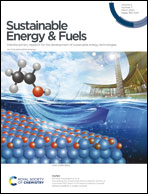Effects of yttrium, ytterbium with tungsten co-doping on the light absorption and charge transport properties of bismuth vanadate photoanodes to achieve superior photoelectrochemical water splitting†
Abstract
Effective water splitting by a photoelectrochemical cell using a BiVO4 photoanode is limited by the light absorption and charge transport properties. Dual doping is one of the promising strategies to overcome this problem. In the present work, the role of individual element W, Y, and Yb doping and (Y,W) and (Yb,W) co-doping in BiVO4 is evaluated towards photoelectrochemical water splitting. Doping Y3+ or Yb3+ at the Bi3+ site leads to an extended absorption region (λ ≤ 550) with a reduced band gap but decreases charge transport properties in comparison to W6+ doping at the V5+ site. Dual doping (Y,W) or (Yb,W) in BiVO4 also shows slightly lower PEC performance than that with the W:BiVO4 photoanode. Charge separation/transfer efficiency measurement reveals that the defects generated especially at the surface with Y3+ or Yb3+ substitutional doping act as a recombination center, leading to lower PEC performance. However, by forming a heterojunction with WO3 along with a surface catalyst (Fe:NiO/Co-Pi) layer for efficient charge transfer, the (Y,W):BiVO4 photoanode shows enhanced performance. In particular, the WO3/(Y,W):BiVO4/Fe:NiO/Co-Pi photoanode shows near complete suppression of recombination of electrons and holes with an improved absorption efficiency (∼85%) and efficient charge transfer (73 ± 4%) as well as shows a remarkable photoelectrochemical performance of 5.8 ± 0.3 mA cm−2 at 1.23 V under 1 sun illumination in the K2HPO4 electrolyte. The photoanode also showed high incident and absorbed photon to current conversion efficiency (∼98%), demonstrating a simultaneous positive effect on the light absorption and charge transport properties.



 Please wait while we load your content...
Please wait while we load your content...